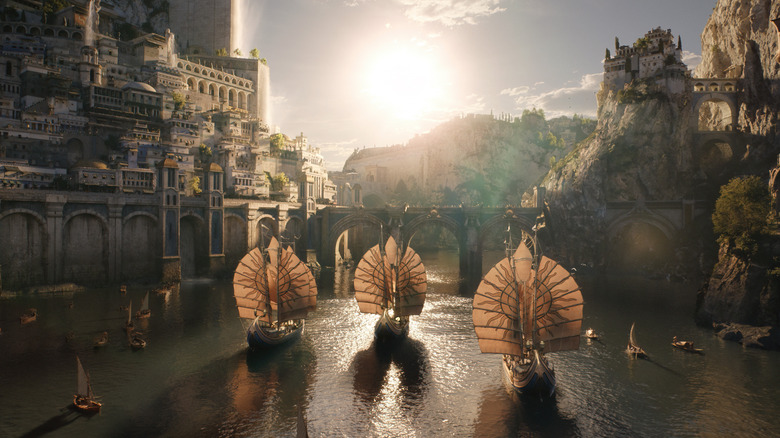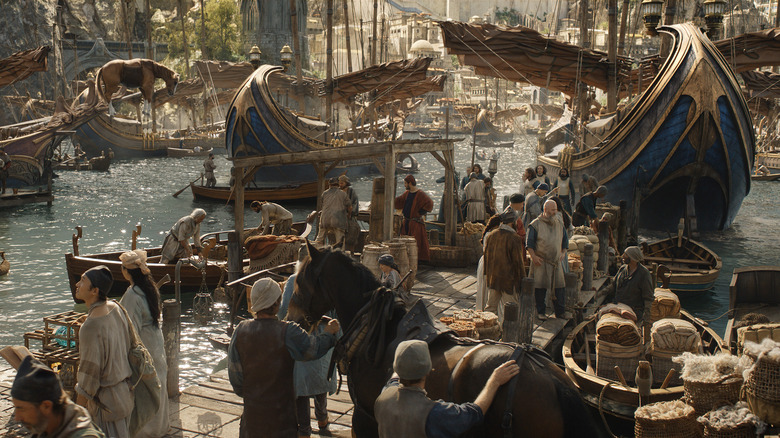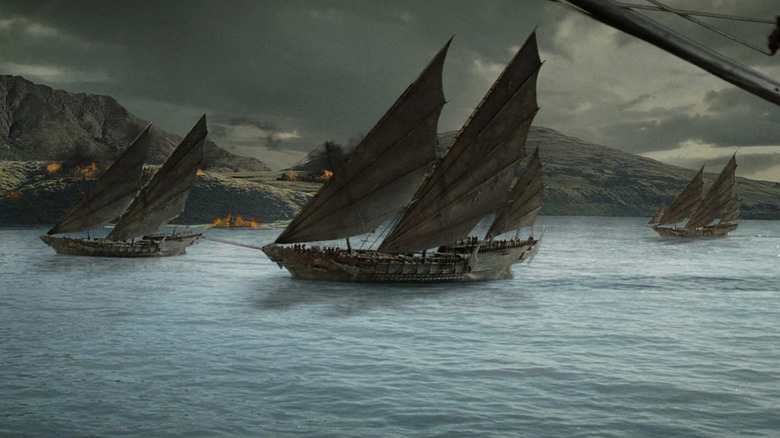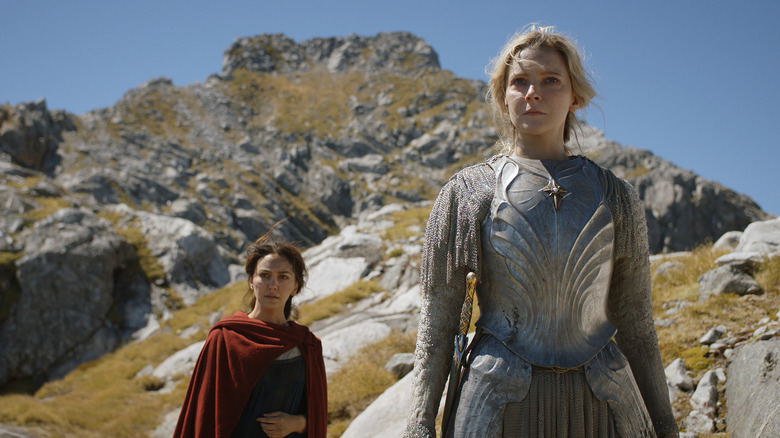The Rings Of Power's Pelargir Explained
Things have not gone well for the Southlanders in the first season of "The Lord of the Rings: The Rings of Power." They went from an oppressed and leaderless nation dealing with a haunting backstory and oppressive Elvish wardens to a scattered people whose home was literally turned to ash. As the penultimate episode of the 1st season wraps up, Bronwyn (Nazanin Boniadi) shares some important information regarding her people's future plans.
With everyone gathered and their wounds dressed, the village healer declares that they can move again. And where do they intend to go with this regained mobility? To an old Númenórean colony called Pelargir. Bronwyn explains that it's near the mouth of the Anduin and that there is fresh land and water. Arondir follows up with the statement that it could be a fresh start for the beleaguered people he's watched for so many decades.
But what is this Pelargir? The show makes it sound like an offbeat, possibly even abandoned settlement. But if you dig through the source material, it is actually a very important place, just not for the Southlanders. It turns out that Pelargir is a critical geographic location for the Númenóreans themselves. Let's take a stroll through the history of Pelargir and consider what kind of impact it could have on the show's future.
Heads up! Potential spoilers for "The Rings of Power" ahead!
The Númenóreans colonize Middle-earth
When the Men of Númenor are given their island at the beginning of the Second Age, the angelic Guardians of the World known as the Valar warn them that they aren't allowed to sail west toward the immortal Blessed Realm (for their own safety). As an alternative, the seafaring nation starts to sail east, back to Middle-earth. Early in their history, they use these trips to visit the local tribes of Humans living along the coasts. "The Silmarillion" informs us that they comfort these unfortunate individuals by teaching them many things and improving their lives. The book says the Númenóreans become revered by their fellow Men, who would hope for them to return quickly, adding, "for at that time the Númenóreans dwelt never long in Middle-earth, nor made there as yet any habitation of their own."
Eventually, as the Númenóreans become unhappy with their mortal fate, their attitude changes and many of them reject the Valar. At one point, during the reign of a particularly jaded king called Tar-Ancalimon, the text says, "Thus it came to pass in that time that the Númenóreans first made great settlements upon the west shores of the ancient lands." It then adds, "Great harbours and strong towers they made, and there many of them took up their abode; but they appeared now rather as lords and masters and gatherers of tribute than as helpers and teachers."
The Faithful found Pelargir
Most of this settling and conquering occurs in the southern regions of the continent, and it's generally pushed as an agenda of the majority political party of Númenor, a group called the King's Men. They reject the Valar and the ways of the past — something we've already seen in "The Rings of Power's" 1st season, primarily through the lens of their most ambitious and dangerous leader, Pharazôn. "The Silmarillion" states, "the King's Men sailed far away to the south; and the lordships and strongholds that they made have left many rumours in the legends of Men."
This group of aggressive and antagonistic individuals is balanced out by their political opponents, called the Faithful. As their name implies, they remain faithful to the past, the Valar, and their Elvish friends. "The Silmarillion" says that the Faithful generally aren't involved in pillaging Middle-earth for its resources. However, they do settle on the mainland to stay connected to their Elven friends, especially in a spot called Pelargir.
The book reads, "In all this the Elf-friends had small part. They alone came now ever to the north and the land of Gil-galad, keeping their friendship with the Elves and lending them aid against Sauron; and their haven was Pelargir above the mouths of Anduin the Great." "The Silmarillion" also explains that the name Pelargir means "Garth of Royal Ships" and it remains an important home base for the Faithful who are eventually persecuted back in Númenor.
Pelargir's Role in the Second Age
Pelargir's location is really important. It's located near the mouth of the Great River Anduin. This is the same body of water that the Orcs cross when they attack Minas Tirith in "The Return of the King." The Fellowship of the Ring traverses the Great River in boats hundreds of miles further north at the end of "The Fellowship of the Ring," too. Heck, if you go even further up on the map, you can even find the spot in this same river where the One Ring was lost, only to be discovered by one Sméagol while fishing with his friend.
Needless to say, this is called the "Great" river for a reason. It's a major Middle-earth waterway, and Pelargir is situated near the point where it finally connects to the sea. It's one of the furthest north settlements that the Númenóreans establish; it's close to Mordor; and a bit later in the Second Age, it becomes a key city in the newly formed kingdom of Gondor. While important, though, Pelargir doesn't play a central role in any of the Second Age stories. It isn't until the Third Age that the city really comes into its own.
Pelargir has a Critical Third Age role
In the Third Age, Pelargir serves as a major city and the primary water-based urban center in Gondor. The city is particularly important during the reign of a group of monarchs called the Ship-kings. These are multiple sea-faring kings of Gondor who give a lot of attention to Pelargir. Some of them even station themselves in the city rather than the capital of Osgiliath. (That's the ruined city Faramir and his troops try to defend in "The Return of the King" movie.)
In the appendices to "The Return of the King," J.R.R. Tolkien says that one of the Ship Kings, an unpopular fellow named Castamir, pushes things even further by stating that he "cared little for the land, and thought only of the fleets, and purposed to remove the king's seat to Pelargir." While he never succeeds in officially moving the capital, it shows how important the city is to Gondor and its people — especially those living near the water.
Pelargir continues to play a critical role in the Gondorian chapter of "The Lord of the Rings," too. When Aragorn leads the Dead Men of Dunharrow (called the Army of the Dead in Peter Jackson's films) to the aid of Minas Tirith, they don't go to the Battle of the Pelennor Fields in the original story. Instead, they travel to Pelargir, where the Dead help to save the city from the attack of the Corsairs of Umbar in their Black Ships. While it's rarely a main element of the story, Tolkien weaves the presence and importance of Pelargir into his narrative throughout the histories of both the Second and Third ages.
How could Pelargir impact The Rings of Power's story?
Of course, the remaining question is how this important Númenórean settlement could factor into the Southlanders' relocation efforts in "The Rings of Power" story. Bronwyn mentions that it's an old colony. Does that mean it's abandoned? Or is it just well-established (and still filled with Númenóreans) at this point in the story? One of the key question marks here is the fact that the show is condensing the Second Age timeline from a few thousand years into a single lifespan. In the appendices for "The Return of the King," it says that Pelargir is built 2,350 years into the Second Age. This is nearly a thousand years before Gondor is founded, which gives it a lot of time to develop into an important city.
If Pelargir is supposed to have the same venerable backstory in "The Rings of Power," perhaps the Southlanders will be joining an already thriving Númenórean settlement filled with the Faithful who will eventually help form the backbone of Gondor. This would be a great way to scale the show into a larger story by an order of magnitude — something that showrunners J.D. Payne and Patrick McKay have already said their actively doing with the project's 2nd season. After a 1st-season production that was hampered by pandemic restrictions, introducing a large, already thriving haven of the Faithful in the form of Pelargir could be an ideal way to level things up quickly. Then again, maybe the show will off-road from the source material completely (they've done so before) and use the Southlanders to make Pelargir important in the first place. It's a question that we likely won't be able to fully answer until we get more of the story in future seasons.





